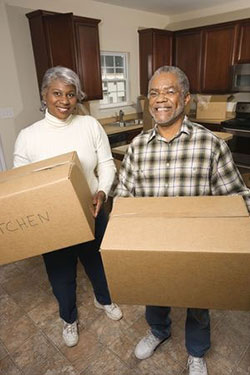 It’s easy to become overwhelmed by the demands of a move into assisted living. It can seem like you have too much to arrange before moving and not enough time to get it all done. You probably have a lot of lingering questions. That’s normal. But you might be overthinking things, too.
It’s easy to become overwhelmed by the demands of a move into assisted living. It can seem like you have too much to arrange before moving and not enough time to get it all done. You probably have a lot of lingering questions. That’s normal. But you might be overthinking things, too.
There are techniques you can use to make your transition to a new assisted living residence successful and easy. Here’s a guide to retirement living in your new home.
How do I start my move?
Fact-finding is always a good first step.
You’ll want to know what furniture of your own that you can, or should, bring. Many communities provide basics like a bed, mattress and dresser. But most retirement communities also want you to feel comfortable in your new digs, so they encourage residents to bring their own furniture.
Before you decide what, if any, of your furniture to bring, you’ll need to measure the dimensions of both your new home and your personal furniture. You probably won’t need all of it, so you’ll need to decide what you’re willing to part with or what you might want to store (although storing unnecessary, non-heirloom furniture is probably a waste of your money).
Don’t forget to measure the doorways in your new home— you need to make sure they have space to allow your furniture to clear. If a piece is too big to fit through the door, it’s definitely something you should consider giving away to family members, selling at a moving sale, or storing.
You’ll also need to know whether or not your retirement community offers any staffers to help carry in your belongings when you pull up to the door on moving day.
Be choosy about what you bring.
Realistically, your new assisted living residence is probably going to be a little smallerthan your previous home (unless you have been renting an apartment on your own) with accordingly smaller amount of closet space and on-site storage. Be judicious about determining what you keep with you.
Say, for example, that you have a hutch full of your mother’s china, but it is of such a size that fitting it into your new residence would make the space cramped. You can ensure the heirlooms stay in the family by offering the china to your daughter, daughter-in-law, or granddaughter.
You can get by; downsizing just takes willingness to part with things and a positive attitude.
Either way, make sure you start packing early, so that you won’t have to rush to make decisions or find moving supplies as the big day approaches.
Visit your retirement community in advance and get to know your future neighbors and the community’s policies.
It would be nice to see a few already-familiar, friendly faces on moving day, wouldn’t it? If you visit your new community in advance of moving and spend some time getting to know the people there, you’ll have a readymade support structure in place once you arrive.
You might even schedule a dinner with your new acquaintances, so that you’ll have some relaxing fun to look forward to once all the activity has subsided. A little bit of downtime may help you to ease into your first night in your new residence.
You’ll also want to familiarize yourself with your retirement community’s activity schedule and policies, so that you know what’s going on, where you can meet other people and how you can go about setting up your new household from the get-go.
Give yourself time to get used to things.
You’re probably going to experience a variety of positive and negative feelings during this move: hope that you will meet new people and have an easier time with day-to-day living, but also wistfulness or even some sadness that you are leaving your home of so many years.
Don’t expect that you’ll move and immediately everything will seem normal and cheery. Just remind yourself to accept that change is an inevitable part of the aging process. With regular exercise and proper nutrition, you can prolong the physical and mental changes that make assisted living necessary, but you cannot stop them entirely. Whether you’re experiencing those changes today or were to experience them a few years from now, there is no avoiding the advance of time.
No one expects your transition to assisted living or senior care to be easy for you. Your family and friends, and the staff, will be patient and help to guide you as you adjust to living in your new retirement community. Just don’t place unrealistic or unnecessary burdens on yourself.
Take your time and enjoy the chance to meet new friends in your new surroundings.












